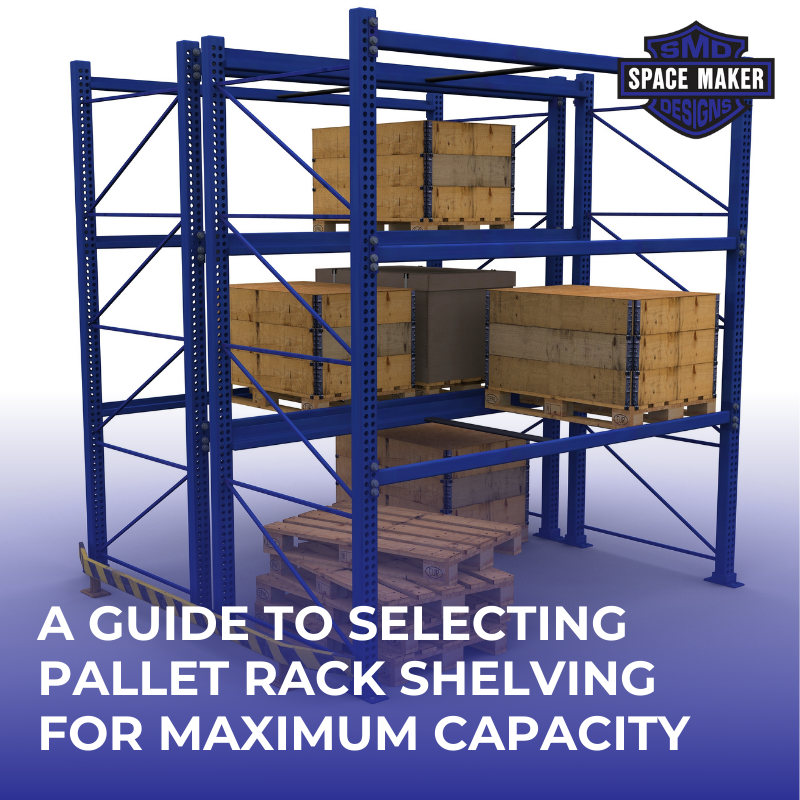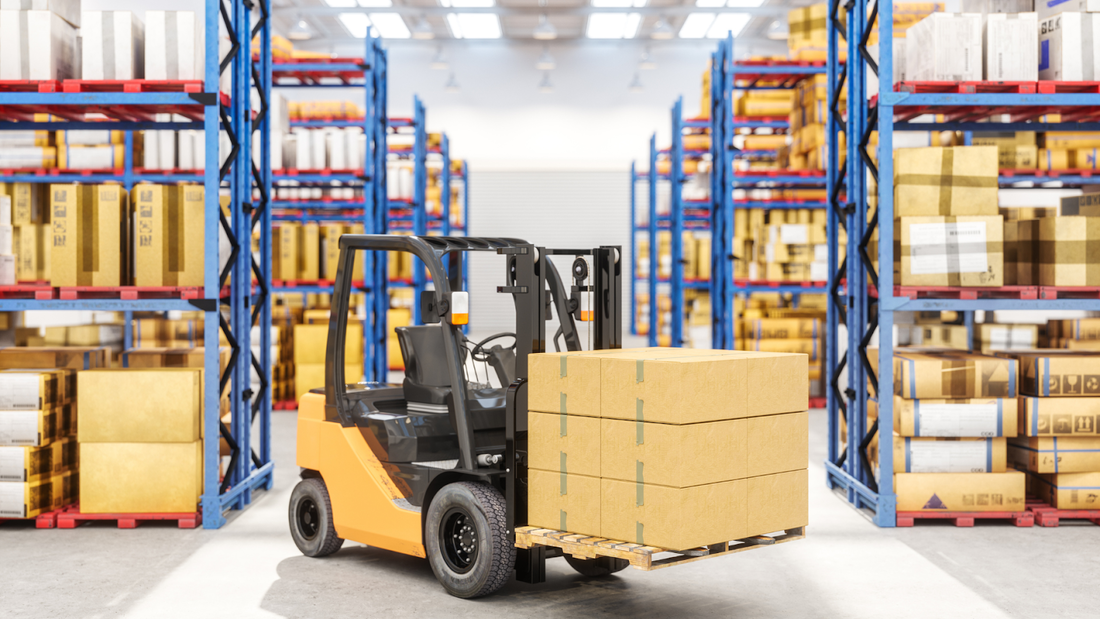Key Takeaways:
- Understand Your Needs and Space: Before selecting a pallet racking system, thoroughly evaluate your warehouse layout, capacity requirements, and the types of goods you store.
- Consider Safety and Compliance: Safety should be a top priority when choosing and installing pallet racking systems. Adhere to safety standards, ensure regular maintenance and inspections, and invest in proper training for your staff
- Maximize Investment Through Strategic Planning: Optimize space utilization, choose scalable and flexible racking solutions, and partner with a reputable supplier like Space Maker Designs. This approach will help you achieve a more efficient, adaptable, and cost-effective storage solution that supports your business's growth and evolving needs.
When it comes to optimizing warehouse space and improving inventory management, selecting the right pallet rack shelving is crucial. This choice not only impacts your current storage capacity but also influences future scalability and operational efficiency. With various types of pallet racking systems available, understanding which one aligns best with your business needs can be a daunting task. However, making the right selection can lead to significant improvements in warehouse organization, safety, and workflow. In this guide, we'll walk through the essential considerations and steps for selecting pallet rack shelving that maximizes your storage capacity and meets your specific requirements.
Space Maker Designs offers Pallet Racks designed to meet your specific needs, ensuring your warehouse is optimized for current and future demands.
Space Maker Designs offers Pallet Racks designed to meet your specific needs, ensuring your warehouse is optimized for current and future demands.
Transform Your Warehouse With Space Maker Designs!
Discover the unbeatable benefits of partnering with Space Maker Designs Inc.:
- Expertise in Refurbishing: We are the South's largest refurbisher of pallet racks, cantilever racks, drive-in racks, pallet-flow racks, push-back racks, and mezzanines.
- 10-Year Warranty: Our Space Maker Rack Repair Kits come with a 10-year warranty, ensuring your investment's longevity.
- Nationwide Installation: Our dedicated crews travel nationwide to install our products, bringing quality and convenience to your doorstep.
- Revolutionary Powder-Coat and Enamel Paint: Our state-of-the-art paint lines make refurbished products look brand new while saving you money.
- Comprehensive Services: From Systems Integration and Auto-CAD Layout and Design to Installation, Delivery, and Pallet Rack Repair, we've got your warehousing needs covered.
Understanding Your Space And Needs
Evaluating Your Warehouse Layout
Before investing in pallet rack shelving, it's essential to thoroughly evaluate your warehouse layout. This assessment should include the floor space, ceiling height, and any physical obstructions like columns or doors. Understanding these dimensions will help you determine the type and size of racking that can be accommodated. Additionally, consider the flow of goods through your warehouse. A well-planned layout should facilitate efficient inventory movement, minimize congestion, and reduce the risk of damage to goods or racking. By mapping out your space, you can identify the most effective racking arrangement that optimizes storage density and accessibility.
Estimating Your Capacity Requirements
Determining your storage needs is a critical step in selecting the right pallet rack shelving. Start by assessing your current inventory volume and consider any projected growth in the near future. Understanding your capacity requirements involves not just the quantity of goods, but also their size and weight. This information will guide you in choosing racking systems that can safely and efficiently accommodate your products. Additionally, consider the turnover rate of your inventory to ensure that the selected racking solution supports your retrieval and replenishment processes without causing delays or bottlenecks.
Identifying Types Of Goods Stored
The nature of the items you're storing plays a significant role in selecting the appropriate pallet rack shelving. Different goods require different storage solutions; for instance, perishable goods might need quicker access and better ventilation, while irregularly shaped items might demand more adaptable storage options. Evaluate whether your products have specific requirements, such as temperature control, protection from light, or stability features. Understanding the characteristics of your goods will help you choose racking systems that not only maximize space but also preserve the quality and accessibility of your inventory.
Types Of Pallet Rack Shelving
Selective Pallet Racking
Selective pallet racking is the most common type of pallet storage system used in warehouses today. It allows for direct access to every pallet, making it an ideal choice for businesses with a wide variety of products and a high turnover rate. This type of racking is highly adaptable to different types of goods and can be adjusted or reconfigured as your storage needs change. However, it requires more floor space compared to other systems due to the need for aisles between racks. When considering selective pallet racking, evaluate your inventory turnover and accessibility requirements to ensure it aligns with your operational needs.
Drive-In and Drive-Thru Racking
Drive-in and drive-thru racking systems are designed for high-density storage. They are best suited for storing large quantities of uniform products, as they allow pallets to be stored deeply on rails running through the racks. Drive-in racking has one entry and exit point, making it a Last In, First Out (LIFO) system, whereas drive-thru racking allows for access from both ends, supporting a First In, First Out (FIFO) workflow. These systems are efficient space savers but require more precise handling and management to prevent damage and maintain inventory accuracy.
Space Maker Designs' Drive-in Rack enhances this setup by offering efficient space utilization and maintaining inventory accuracy.
Space Maker Designs' Drive-in Rack enhances this setup by offering efficient space utilization and maintaining inventory accuracy.
Push Back And Pallet Flow Systems
Push back and pallet flow systems are dynamic solutions that provide high-density storage while maintaining selectivity. Push back racking allows pallets to be stored up to six deep on either side of an aisle, with each new pallet pushing the previous ones back. This system operates on a LIFO basis and reduces aisle space requirements. Pallet flow systems, on the other hand, use gravity rollers to allow pallets to 'flow' towards the front of the rack for pick-up, supporting a FIFO workflow. These systems are ideal for storing perishable goods or items with expiration dates. Both push back and pallet flow racking increase storage density and reduce the need for multiple aisles, but they require a higher initial investment and are best suited for specific types of inventory.
Factors To Consider When Choosing Pallet Racking
Weight Capacity And Load Type
When selecting pallet rack shelving, it is critical to consider the weight capacity and the type of loads they will support. Each racking system has a maximum load capacity, and exceeding this limit can lead to structural failure and potential accidents. Assess the average weight of your pallets and ensure that the chosen racking can comfortably support this weight over its entire area. Additionally, consider the load type — uniform, evenly distributed loads are different from concentrated loads. Choosing a racking system that matches your load type and weight ensures safety and longevity of your storage solution.
Accessibility And Handling
Accessibility is a vital factor in the efficiency of warehouse operations. The type of pallet racking should align with the frequency and ease with which items need to be accessed. For example, selective racking offers high accessibility, suitable for a wide variety of products with varying turnover rates. Consider the type of material handling equipment used in your warehouse, such as forklifts or pallet jacks, as this will also influence the choice of racking. Adequate space for safe and efficient operation of this equipment is essential to prevent damage to the racks and ensure worker safety.
Scalability And Flexibility
Future growth and changes in inventory are important considerations when selecting pallet racking. Opt for a system that offers scalability and flexibility to adapt to changing business needs. Modular systems that allow for easy expansion or reconfiguration can accommodate future growth or changes in product lines. Consider whether the racking can be adjusted in height, length, or layout without significant disruptions. Selecting a scalable and flexible racking solution can provide long-term benefits, reducing the need for costly warehouse redesigns or additional racking systems in the future.
Safety And Compliance
Understanding Rack Safety Standards
Safety should be a paramount concern when selecting and installing pallet racking systems. It's essential to understand and comply with local, national, and industry-specific safety standards and regulations. These standards are designed to ensure the safe construction, installation, and use of pallet racking systems. They cover aspects such as load capacities, aisle widths, and the use of safety accessories like guard rails and wire decking. Adhering to these standards helps prevent accidents, protect workers, and avoid costly fines or legal issues.
Regular Maintenance And Inspection
Regular maintenance and inspection are crucial to the long-term safety and integrity of pallet racking systems. Scheduled inspections should be conducted by qualified individuals to identify and address potential issues, such as damage, corrosion, or misalignment, which could compromise the racking's structural integrity. Employees should be trained to report any signs of damage or wear and tear immediately. Implementing a routine maintenance program helps extend the lifespan of the racking system and ensures the safety of warehouse operations.
Training And Safety Protocols
Implementing comprehensive training and safety protocols is essential for ensuring the safe operation of pallet racking systems. Employees should be trained on proper load handling, weight distribution, and forklift operation. They should also be aware of the racking systems' specifications and load capacities to avoid overloading and potential collapses. Establishing clear safety protocols, including proper signage, aisle markings, and emergency procedures, can significantly reduce the risk of accidents and injuries in the warehouse.
Maximizing Your Investment
Cost-Effectiveness And Budgeting
Establish a clear budget that accounts for the initial purchase and installation costs and also long-term expenses such as maintenance, expansions, and potential repairs. Cheaper options might not always be the best in the long run, especially if they compromise on quality or do not meet your specific needs. Consider the total cost of ownership and look for racking systems that offer durability and adaptability without exceeding your budget.
Maximizing Space Utilization
Maximizing space utilization is essential to get the most out of your investment. Choose a pallet racking system that optimizes warehouse space without sacrificing accessibility and efficiency. Consider different racking layouts and configurations to find the one that best fits your space and storage needs. Utilizing vertical space, choosing the right type of racking system, and implementing an efficient warehouse layout can significantly increase your storage capacity and operational efficiency.
Partnering With The Right Supplier
Choosing the right supplier is as important as selecting the right pallet racking system. Look for suppliers with a good reputation, extensive experience, and a commitment to quality and service. A reliable supplier will not only provide high-quality products but also offer valuable advice, design assistance, and after-sales support. They should understand your needs and be able to provide tailored solutions that meet your specific requirements. A strong partnership with the right supplier can ensure that you receive the best value for your investment and support throughout the life of your racking system.
Final Thoughts
Selecting the right pallet rack shelving is a crucial decision that impacts the efficiency, safety, and scalability of your warehouse operations. By understanding your space and needs, evaluating different types of pallet racking, considering key factors such as weight capacity, accessibility, and safety, and maximizing your investment through careful planning and partnership with the right supplier, you can ensure that your warehouse is equipped to meet current and future demands. We hope this guide has provided you with valuable insights as you select pallet rack shelving for your warehouse.
Space Maker Designs' Pallet Racks offer tailored solutions that meet your warehouse needs, ensuring your business is prepared for current and future demands.
Read also:
Space Maker Designs' Pallet Racks offer tailored solutions that meet your warehouse needs, ensuring your business is prepared for current and future demands.
Read also:
- How To Find Affordable Pallet Shelves In Dallas
- The Essential Rack Repair Kit: Keeping Your Storage Systems In Top Shape
- How To Comply With OSHA Regulations In Your Warehouse
Frequently Asked Questions
How much weight can a pallet rack hold?
The weight capacity varies based on rack type, material, and configuration. It's essential to know the weight of your products to choose a suitable system.
How do I choose the right pallet rack?
Consider factors such as storage density, inventory accessibility, floor space, building height, and inventory rotation when selecting a pallet rack system.
What is the difference between new and used pallet racking?
New pallet racks offer convenience and reliability, while used ones can provide cost savings but require careful evaluation of condition and compatibility.
Do I need safety accessories for pallet racking?
Yes, safety accessories like rack guards, enclosures, and industrial safety guardrails are essential to protect workers and enhance the safety of your storage system.
How can I ensure the pallet racking fits my space?
Assess the height, depth, and layout of your facility, considering future storage needs and room for add-on parts.
What are the benefits of selective pallet racking?
Selective pallet racking offers easy access to pallets, flexibility, and is ideal for operations with low volume or high differentiation product lines.
What is FIFO and LIFO, and how do they relate to pallet racking?
FIFO (First In, First Out) and LIFO (Last In, First Out) are inventory management strategies that influence the type of pallet racking you might need, such as pallet flow racks for FIFO or pushback racks for LIFO.
What should I consider regarding load capacity?
Understand the maximum and average weight of your pallet loads to ensure the rack can safely support them.
How do I assess the condition of used pallet racks?
Evaluate the structural integrity and stability of used pallet racks, looking for signs of wear, damage, or rust.
What should I know about the delivery and installation of pallet racks?
Opt for suppliers offering full delivery and installation services to ensure correct setup and safety.



